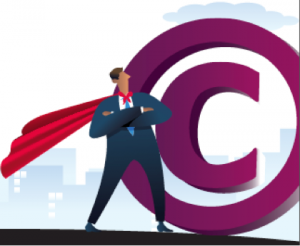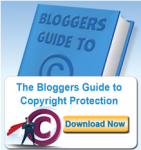5 Critical Copyright Guidelines for Bloggers
 What are the basic rules of copyright protection for bloggers?
What are the basic rules of copyright protection for bloggers?
First and foremost: When it comes to writing, sharing, and republishing other people’s content, the golden rule applies:
Do unto others, as you would have them do unto you.
Always get permission before posting another person’s copyrighted work on your blog or website!
This is true for all kinds of content, including graphics, text, audio, and video.
Here are 5 more copyright guidelines to remember as you seek to protect your own content.
5 Copyright Guidelines to Protect Your Blog:
- You own the copyrights to all your original content as soon as you create it. No one can lawfully use your original content without your permission, except if it complies with the guidelines regarding fair use.
This is true whether or not you display a copyright symbol or copyright notice, or register your content with the U.S. Copyright Office. (Note: content creators in other nations enjoy similar protections but registration details and requirements vary.)
2. You don’t have to register your work with the U.S. Copyright Office. While not required, some authors and content creators do take this additional step. You can learn more about the process in this document from the U.S. Copyright Office. Registering your content expands your legal options should a dispute over ownership arise.
Update: Additional clarification for bloggers, from IP expert Kyle-Beth Hilfer, writing on the topic in Neal Schaeffer’s blog: ” … Most people do not register each blog post, it’s expensive and cumbersome. Some choose to do it quarterly as collective works, but this is a personal choice. If there is a post that is particularly important, some people choose to register that separately. Practices vary widely and each person/company must conduct a cost/benefit analysis to determine its own best practices on filing.”
3. Add the © symbol to your footer. It’s not required to affix the copyright symbol © or display a copyright notice in the footer of your blog. However, many bloggers do this in order to put readers on notice that they will defend their copyrights and to deter potential infringers. It costs nothing, so you certainly should do this.
4. Create a Terms of Use for your site and the material on it. This can serve as a way to let readers know what you will allow, and give people a process for contacting you to gain permission, as well as dissuade potential infringers.
5. Understand your options to remedy copyright infringement. Sooner or later, your online content will be used without your permission. This can be a nasty surprise, so take steps to detect it in advance, so you can deal and mitigate he negative consequences swiftly.
What if Your Copyrights Are Infringed?
Unfortunately, we’re all vulnerable to infringement online and off line. Not everyone takes the moral highroad when it comes to respecting other people’s copyrights. Protect your work in advance, using the 5 guidelines outlined above, and stay vigilant about detecting unauthorized reuses of your content.
One way to do that, is with Discovery™ - iCopyright’s infringement detection service.
Also, an understanding of the (DMCA) Digital Millennium Copyright Act will help you get infringing content removed quickly, when and if it occurs.
(Read this previous blog post, to learn more about using the DMCA takedown notice to deal with copyright infringements).
Free Ebook: The Blogger’s Guide to Copyright Protection
If you would like to learn more about how to copyright a blog, and what to do if your copyrights are infringed, you might be interested in our free e-book:
The Blogger’s Guide to Protection
Let us know if you have any other copyright questions, in the comments!
